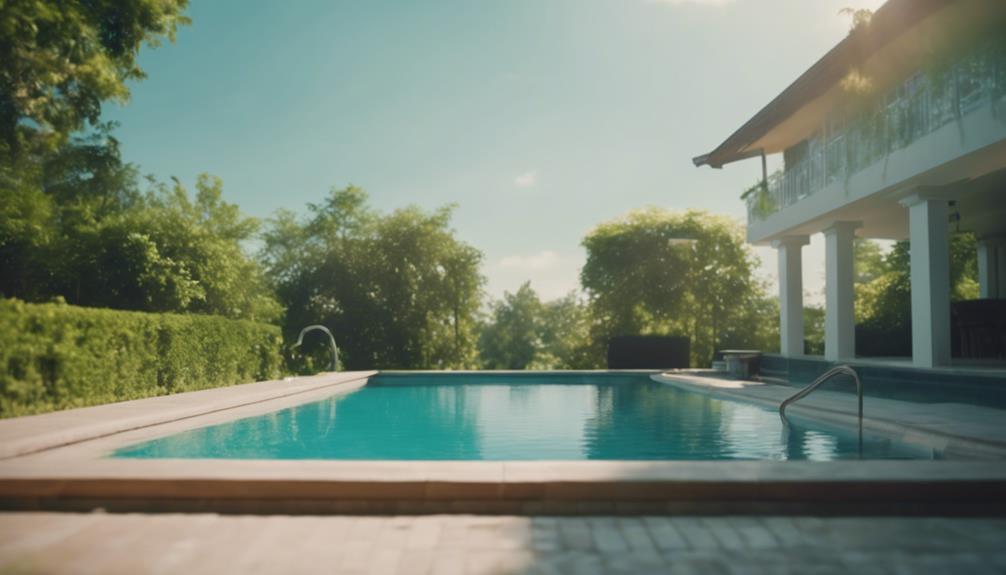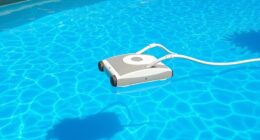For a pleasant swim, keep the pool temperature between 78°F to 85°F. Anything below 78°F might feel too cold, while temperatures above 85°F can be too warm. This optimal range helps prevent discomfort and muscle cramps. Regularly checking and adjusting the temperature improves your swimming session. Keeping a close eye on the levels will maintain a comfortable swimming environment. Gradually adjusting the temperature can help prevent muscle fatigue and cramps. By staying within this temperature range, you are promoting a healthy chemical balance for the best water quality.
Key Takeaways
- Ideal pool temperature range: 78°F to 85°F enhances comfort and swimming experience.
- Avoid muscle cramps by keeping pool temperature below 85°F with gradual adjustments.
- Consistent monitoring below 85°F maintains chemical balance and water quality.
- Overheating above 85°F risks cramps, affects swimmers physically, and hinders pool chemicals.
- Lower pool temperature by adding water features, partial draining, and providing shade to prevent overheating.
Ideal Temperature Range
To optimize your swimming experience, it's important to maintain the pool temperature within the ideal range of 78°F to 85°F. Water temperature plays a vital role in ensuring your comfort while swimming.
Temperatures below 78°F can leave you shivering and feeling uncomfortable, impacting your enjoyment of the water. On the other hand, water temperatures above 85°F might feel too warm for many swimmers, potentially making the experience less invigorating.
By adjusting the pool temperature within this specified range, you can enhance your overall swimming experience. Consistency in monitoring and maintaining the water temperature is key to ensuring that swimmers can enjoy the pool comfortably.
To make the most of your time in the water, paying attention to the swimming pool temperature and keeping it within the recommended range will help you have a more pleasant and enjoyable swim.
Avoiding Muscle Cramps

Maintaining the pool temperature below 85°F is essential in preventing muscle cramps while swimming. Overheating in warm water can lead to muscle fatigue and increase the likelihood of cramps. To avoid this, make sure the water temperature stays within a comfortable range.
Muscle cramps are more common in temperatures above 85°F, so keeping it below this threshold is vital for a smooth swimming experience. Sudden shifts to warmer water can also trigger cramps, so gradual adjustments are key. Hydrating adequately before swimming and performing proper warm-up exercises can further help prevent muscle cramps.
Promoting Chemical Balance

Keeping your swimming pool temperature below 85°F not only helps prevent muscle cramps but also plays a significant role in promoting chemical balance for ideal water quality.
Maintaining a consistent pool temperature within the range of 78-85°F is important for controlling algae and bacteria growth, as well as ensuring that pool chemistry functions effectively for water sanitation.
Fluctuations in pool water temperature can have a direct impact on the overall chemical balance and water quality, leading to potential issues with clarity and safety.
By monitoring and adjusting the pool temperature regularly, you can actively promote the right conditions for ideal pool chemistry. This proactive approach not only supports the longevity of your pool but also contributes to a more enjoyable and healthier swimming experience for you and your guests.
Importance of Consistent Monitoring

Consistently monitoring your pool temperature is essential for ensuring the comfort and safety of swimmers. By keeping an eye on the pool temperature regularly, you can maintain ideal conditions for a pleasant swimming experience.
Here are a few reasons why monitoring is vital:
- Using a floating thermometer allows you to easily track and adjust the pool temperature to the desired range.
- Monitoring helps prevent sudden fluctuations in pool water temperature, which can impact the chemical balance of the pool.
- Regular temperature checks aid in controlling the growth of algae and bacteria, ensuring a clean and safe swimming environment.
Effects of Overheating

Monitoring your pool temperature is vital to prevent overheating, as it can lead to muscle cramps and discomfort for swimmers. When the temperature of your pool water rises above 85°F, the risk of experiencing these unpleasant effects increases. Overheating not only affects swimmers physically but also impacts the chemical balance of the pool. High temperatures can hinder the effectiveness of chemicals, potentially leading to water quality issues.
To avoid complications, it's essential to keep the temperature of your pool below 85°F. By doing so, you can prevent the growth of algae and bacteria, ensuring a safe and enjoyable swimming environment. Consistent monitoring and regulation of your pool temperature play a significant role in maintaining both the health and comfort of those using the pool.
Lowering Pool Temperature

To keep your swimming pool at a comfortable temperature, consider adding water features like waterfalls or fountains that aid in cooling through evaporation.
Partially draining and refilling the pool can also help in lowering the water temperature for a more enjoyable swim.
Providing shade in the pool area prevents direct sunlight, further assisting in reducing the pool temperature, ensuring a pleasant swimming experience.
Benefits of Lowering Temperature
Lowering your pool temperature can lead to significant energy cost savings while still providing an invigorating swimming experience. Here are some benefits to ponder:
- Reduced Energy Costs: By lowering the pool temperature, you can decrease the energy consumption of your heating system, ultimately saving you money on utility bills.
- Natural Cooling: Adding water features like fountains or waterfalls can help naturally cool the pool water, making it more revitalizing for your swims.
- Shade for Cooling: Providing shade in the pool area can help prevent direct sunlight from heating up the water, maintaining a cooler temperature for a more pleasant swim.
Consider utilizing reversible heat pumps to efficiently lower the pool temperature while keeping energy usage in check. Remember to regularly test and treat the pool water to prevent bacteria growth, especially when operating at cooler temperatures.
Enjoy the benefits of a comfortably cool pool while saving on energy costs.
Impact on Pool Health
When considering the impact on pool health, adjusting the temperature can play a significant role in preventing the proliferation of bacteria and algae in your pool. Lowering the pool temperature helps inhibit the growth of these unwanted organisms, maintaining better pool hygiene. Algae and bacteria growth thrive in warmer water, so keeping the temperature at an ideal level is essential for effective pool maintenance.
To prevent bacteria and algae from taking over your pool, consider using effective cooling methods such as adding waterfalls or partially draining the pool to lower the temperature.
Consistent monitoring and adjustments in pool temperature are essential to control algae and bacteria growth and maintain optimal pool health.
Effects of Cold Water

Cold water can quickly chill your muscles, leading to decreased blood circulation and slower reaction times. This can result in reduced performance and discomfort during swimming sessions.
It's essential to be mindful of these effects and take necessary precautions when swimming in colder waters.
Chilling Muscles Quickly
Swimming in water with temperatures below 77°F can quickly chill your muscles, impacting your comfort and performance in the pool. When muscles are exposed to cold water, several effects can be observed:
- Decreased Muscle Relaxation: Cold water can hinder muscle relaxation, leading to stiffness and reduced flexibility during swimming sessions.
- Increased Discomfort: The chilly temperatures can cause discomfort, making it harder to maintain a smooth and efficient swimming technique.
- Impaired Performance: Cold water may decrease blood flow to muscles, affecting their ability to generate power and endurance in the pool.
To prevent these issues, it's essential to gradually acclimate to colder water temperatures and consider using appropriate gear like wetsuits or thermal caps. By taking these precautions, you can minimize the negative impact of chilly water on your muscles and enhance your overall swimming experience.
Decreased Blood Circulation
Experiencing decreased blood circulation in lower water temperatures can have notable effects on your body's performance and comfort while swimming. When swimming in cold water, your blood vessels constrict, reducing blood flow to your extremities. This can lead to muscle stiffness, decreased flexibility, and a higher risk of hypothermia due to lowered core body temperature.
The body's cold shock response may kick in, affecting your heart rate and breathing as it tries to adapt to the cold environment. To keep your swimming pool comfortable and safe, it's essential to be aware of these effects and take precautions. Staying active in cold water can help maintain circulation and warmth, but be mindful of the signs of hypothermia.
Remember to gradually acclimate yourself to colder temperatures and consider wearing appropriate gear to minimize the impact of decreased blood circulation.
Slower Reaction Times
In water temperatures below 77°F, your reaction times may slow down, and coordination could be impaired. This can greatly impact your swimming performance and overall safety in the pool.
Here are some key points to keep in mind regarding the effects of cold water on your reaction times and coordination:
- Slower reaction times: Cold water can cause delays in how quickly your body responds to stimuli, making it harder to adjust your movements.
- Impaired coordination: The chilliness of the water can affect your ability to move smoothly and efficiently, leading to potential issues with stroke technique.
- Decreased muscle flexibility: Cold water can stiffen your muscles, making it harder to execute movements with the same range of motion as in warmer temperatures.
Maintaining a suitable pool temperature is crucial to make sure that your reaction times remain sharp and your coordination stays on point while swimming. By keeping the water comfortably warm, you can enhance your performance and enjoyment in the pool.
Raising Pool Temperature

To elevate the temperature of your swimming pool, contemplate utilizing sunlight and heat pumps as effective methods for enhancing comfort and relaxation for swimmers.
You can harness the power of the sun by covering your pool when not in use to retain warmth and minimize heat loss. Additionally, relocating patio umbrellas and trimming foliage can optimize sunlight exposure, naturally heating your pool.
For a more controlled approach, reversible heat pumps can efficiently raise the pool temperature, providing a more enjoyable swimming experience.
When looking to raise the temperature, a pool heater is another option to ponder. By keeping your pool at a comfortable warmth, swimmers can relax and enjoy their time in the water.
Whether you choose to go the route of solar heating or invest in a heat pump, ensuring that your pool is at the right temperature can make a significant difference in the overall swimming experience.
Advantages of Comfortable Temperature

Maintaining a comfortable swimming pool temperature enhances relaxation and enjoyment for swimmers of all ages and preferences. When the water is kept within the ideal temperature range of 78-85°F, it creates a soothing environment that caters to diverse age groups and preferences.
Here are some advantages of keeping your pool water at a comfortable temperature:
- Enhanced Relaxation: Ideal water temperatures contribute to a calming and stress-relieving swimming experience.
- Improved Enjoyment: A comfortable pool temperature enhances the overall enjoyment of swimming activities for both leisure and exercise.
- Encourages Regular Use: By maintaining a consistent water temperature within the comfort zone, it encourages swimmers to frequent the pool more often, leading to a healthier and more active lifestyle.
Frequently Asked Questions
What Is the Most Comfortable Pool Temperature?
For the most comfortable pool temperature, aim for 78 to 82 degrees Fahrenheit. 80 degrees is often perfect for kids and seniors. Balancing comfort and cost is essential. Customize settings to find your ideal balance.
Is 80 Degree Pool Comfortable?
Feeling the perfect balance, a pool at 80 degrees wraps you in warmth without the burn. It's the sweet spot where comfort meets joy, inviting you to swim, play, and unwind in pure bliss.
Is 70 Degree Water Too Cold to Swim?
Yes, 70-degree water might feel too cold for you to swim comfortably. Most swimmers find temperatures below 70°F too chilly, causing shivering and decreased mobility. Ideal swimming conditions are usually maintained above 70°F.
Is 75 a Good Temperature for Swimming?
For your swimming comfort, 75 degrees is a decent temperature. It may feel cool at first, but it can be invigorating for quick dips. Adjust based on your preferences and activities for an enhanced swim experience.
Conclusion
In summary, maintaining the most important swimming pool temperature is essential for a relaxing and enjoyable experience. Just like Goldilocks searching for the perfect porridge, finding the ideal temperature is key to avoiding muscle cramps, promoting chemical balance, and preventing overheating or discomfort.
So, keep an eye on the thermometer, make adjustments as needed, and immerse into the perfect pool temperature for a revitalizing swim every time.










